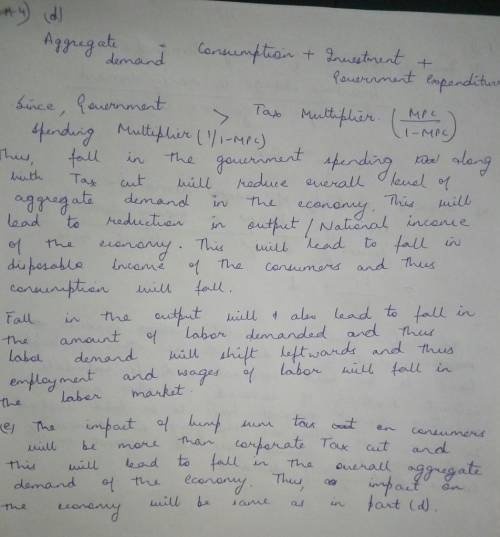
Business, 28.02.2020 01:48 catuchaljean1623
Consider an economy with one representative consumer, one representative firm and the government. Suppose that the consumer has one unit of labor and she supplies her labor inelastically. That means she works a fixed amount N, no matter what the wage is. The consumer's budget constraint is c = WN + Tt, and it is firm's profit. To simplify the question, assume the firm uses only labor input with the production function y = 2N1-4. The firm must pay a proportional tax on its revenue at tax rate Ty. The government funds its spending g from the corporate tax. a. Set up and solve for the firm's labor demand. Use diagram to determine the wage and employment in equilibrium. Now suppose that the government reduces the corporate tax. The corporate tax rate becomes t2 <11. b. What happens to the firm's labor demand? On the same diagram from (a), show the new labor market equilibrium. c. What happens to the consumption and output in equilibrium? Consider the fact that to fund the tax cut, the government must either reduce spending or increase some other tax. d. Suppose that the government reduces government spending by the amount needed to fund the tax cut. Now what happens on net to wages, employment, consumption and output?

Answers: 1
Another question on Business

Business, 21.06.2019 20:30
Which of the following mechanisms would be most likely to motivate managers to act in the best interests of shareholders? a) decrease the use of restrictive covenants in bond agreements, b) take actions that reduce the possibility of a hostile takeover, c) elect a board of directors that allows managers greater freedom of action, d) increase the proportion of executive compensation that comes from stock options and reduce the proportion that is paid as cash salaries, e) eliminate a requirement that members of the board directors have a substantial investment in the firm's stocks
Answers: 2

Business, 22.06.2019 03:00
Presented below is a list of possible transactions. analyze the effect of the 18 transactions on the financial statement categories indicated. transactions assets liabilities owners’ equity net income 1. purchased inventory for $80,000 on account (assume perpetual system is used). 2. issued an $80,000 note payable in payment on account (see item 1 above). 3. recorded accrued interest on the note from item 2 above. 4. borrowed $100,000 from the bank by signing a 6-month, $112,000, zero-interest-bearing note. 5. recognized 4 months’ interest expense on the note from item 4 above. 6. recorded cash sales of $75,260, which includes 6% sales tax. 7. recorded wage expense of $35,000. the cash paid was $25,000; the difference was due to various amounts withheld. 8. recorded employer’s payroll taxes. 9. accrued accumulated vacation pay. 10. recorded an asset retirement obligation. 11. recorded bonuses due to employees. 12. recorded a contingent loss on a lawsuit that the company will probably lose. 13. accrued warranty expense (assume expense warranty approach). 14. paid warranty costs that were accrued in item 13 above. 15. recorded sales of product and related service-type warranties. 16. paid warranty costs under contracts from item 15 above. 17. recognized warranty revenue (see item 15 above). 18. recorded estimated liability for premium claims outstanding.
Answers: 1

Business, 22.06.2019 11:40
You are a manager at asda. you have been given the demand data for the past 10 weeks for swim rings for children. you decide to run multiple types of forecasting methods on the data to see which gives you the best forecast. if you were to use exponential smoothing with alpha =.8, what would be your forecast for week 22? (the forecast for week 21 was 1277.) week demand 12 1317 13 1307 14 1261 15 1258 16 1267 17 1256 18 1268 19 1277 20 1277 21 1297
Answers: 3

Business, 22.06.2019 12:50
Jallouk corporation has two different bonds currently outstanding. bond m has a face value of $50,000 and matures in 20 years. the bond makes no payments for the first six years, then pays $2,100 every six months over the subsequent eight years, and finally pays $2,400 every six months over the last six years. bond n also has a face value of $50,000 and a maturity of 20 years; it makes no coupon payments over the life of the bond. the required return on both these bonds is 10 percent compounded semiannually. what is the current price of bond m and bond n?
Answers: 3
You know the right answer?
Consider an economy with one representative consumer, one representative firm and the government. Su...
Questions

Social Studies, 15.07.2019 02:50


Business, 15.07.2019 02:50

Chemistry, 15.07.2019 02:50

History, 15.07.2019 02:50

Chemistry, 15.07.2019 02:50

Business, 15.07.2019 02:50

Social Studies, 15.07.2019 02:50

History, 15.07.2019 02:50

Biology, 15.07.2019 02:50

Biology, 15.07.2019 02:50

Social Studies, 15.07.2019 02:50




Business, 15.07.2019 02:50




Chemistry, 15.07.2019 02:50




